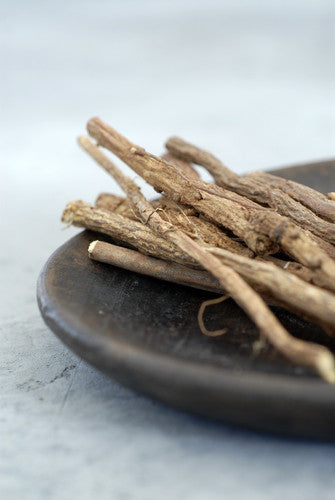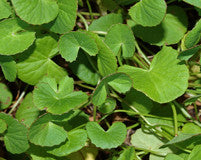
natural brightener: licorice root

Licorice root (Glycyrrhiza glabra) is also known as mulethi (Hindi) or yastimadhu (Sanskrit). It is a popular Ayurvedic herb found throughout South Asia, the Middle East, and China. Its principle constituent, glycyrrhizin, is significantly sweeter than sugar, and has been used in traditional medicines to mask the taste of other ingredients. The Egyptians favored it for flavoring, and included it in the tomb of King Tut for his journey into the afterlife. Pliny the Elder used it to clear his voice and alleviate hunger and thirst, while Dioscides recommended it to his troops to improve stamina. In the Middle Ages it was used to negate the effects of very spicy or overcooked food.
The Ayurvedic literature describes licorice root as a rasayana, or rejuvenative, which has been used in various formulations to promote hormonal balance, libido, and normal function of the adrenal glands. It is used to reduce vata and pitta imbalances while increasing kapha. In traditional Chinese medicine, licorice root has been used to “harmonize” contrasting herbs in various formulas since as early as 190 AD.
Glycyrrhizin has been scientifically demonstrated to possess anti-viral, anti-microbial, anti-oxidant, and anti-inflammatory activity. It also contains a tyrosinase inhibitor, which help to stop the chain reaction that results in the deposition of melanin into the skin. It is a safe and effective alternative to other lightening agents, including hydroquinone. It is one of the star ingredients in both our Amla Skin Brightening Lotion and our Black Tea & Licorice Root Brightening Cleanser.
1www.wikipedia.org
2www.mountainroseherbs.com


1 comment
Cet article sur la racine de réglisse est une plongée concise et informative dans les multiples bénéfices de cette plante ! Après avoir lu cet article, je suis incité à explorer davantage les utilisations de la racine de réglisse pour améliorer ma santé. Merci pour cette introduction succincte mais complète à cette racine aux multiples bienfaits !
Des réductions sur des produits similaires sont disponibles ici : https://www.couponcodeguide.com/en/coupon-codes/iherb.com/iherb-coupon-code-worldwide
iherb
leave us a comment
This site is protected by reCAPTCHA and the Google Privacy Policy and Terms of Service apply.